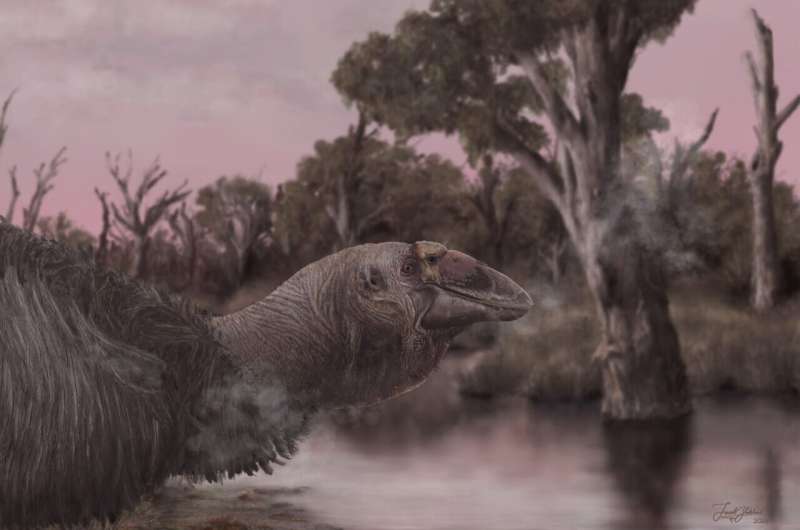This article has been reviewed according to Science X's editorial process and policies. Editors have highlighted the following attributes while ensuring the content's credibility:
fact-checked
peer-reviewed publication
trusted source
proofread
Giant skull of Australian megafauna bird reveals a prehistoric 'giga-goose'

After 128 years of exploration, fossil excavation and investigation, Flinders University researchers have finally uncovered the skull of Australia's own giant and charismatic megafauna bird—Genyornis newtoni.
The only previously known skull for this species, reported in 1913, was heavily damaged and with little of the original bone remaining, not much could be deduced about the skull of this species. Now, with these new fossils, excavated from the saline, dry beds of Lake Callabonna, a remote region of inland South Australia, lead author Phoebe McInerney and colleagues can reveal what this species really looked like.
The fossils, discovered during Flinders University Paleontology Lab field trips to Lake Callabonna in 2019, were associated with near complete fossils of the body, confirming the skull's attribution to Genyornis newtoni, a species which went extinct about 45,000 years ago.
The description of the structure of this remarkable skull, now published in the journal Historical Biology, provided researchers with the basis for exploring the ecology, functional morphology, and evolutionary relationships of these giant birds.
As expected from such a giant (approximately 230 kg), around five times the weight of the Southern Cassowary, the skull of Genyornis newtoni was far from ordinary, with massive braincase, large upper and lower jaws, an unusual casque on the top of its head. The upper beak especially, showed surprising morphology, differentiating this bird from even its closest relatives, which are otherwise fairly similar.
"Genyornis newtoni had a tall and mobile upper jaw like that of a parrot but shaped like a goose, a wide gape, strong bite force, and the ability to crush soft plants and fruit on the roof of their mouth," says Flinders University researcher Phoebe McInerney.
Aspects of the skull also showed undeniable and complex similarities to that of early diverging waterfowl lineages, the South American Screamers and, a bit closer to home, the Australian Magpie Goose.
"The exact relationships of Genyornis within this group have been complicated to unravel; however, with this new skull we have started to piece together the puzzle which shows, simply put, this species to be a giant goose," she says.
"We were particularly excited to discover the first fossil upper bill of Genyornis. For the first time we could put a face on this bird, one very different to any other bird, yet like a goose," says co-author Dr. Trevor Worthy.
Assessing the morphology of the skull also provided researchers with an in-depth view of how the head would have functioned by making an assessment on the muscles and available movement in each of the joints.
Jacob Blokland, a co-author of the article, says, "The form of a bone, and structures on it, are partly related to the soft tissues that interact with them, such as muscles and ligaments, and their attachment sites or passages.
"Using modern birds as comparatives, we are able to put flesh back on the fossils and bring them back to life," says Mr. Blokland, who has brought Genyornis newtoni back to life through a scientifically accurate reconstruction.
In addition, this study found these giant birds had several unusual adaptations for aquatic habitats, allowing for the protection of their ears and throat from an influx of water when the head is submerged.
These adaptations further support Genyornis being no other than a giant prehistoric goose and are potentially linked to its extinction as fresh water bodies in northern South Australia are now mostly salt lakes.
With this skull, researchers now know so much more about Genyornis newtoni than ever before, having gained a greater understanding of these birds which once broadly roamed the Australian outback and their ultimate disappearance.
More information: Phoebe L. McInerney et al, Skull morphology of the enigmatic Genyornis newtoni Stirling and Zeitz, 1896 (Aves, Dromornithidae), with implications for functional morphology, ecology, and evolution in the context of Galloanserae, Historical Biology (2024). DOI: 10.1080/08912963.2024.2308212
Journal information: Historical Biology
Provided by Flinders University





















